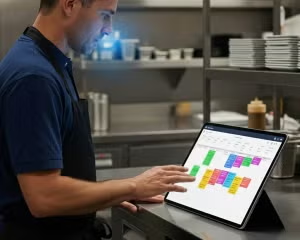You can’t manage what you don’t measure.
This old business-school adage lies at the heart of benchmarking.
Benchmarking is an excellent tool for monitoring and improving your performance. That goes for hospitals, retirement homes, rehab facilities, residential-treatment centers, and any healthcare organization that serves food.
A self-improvement process that enables managers to compare their operation with others, food service operation benchmarking can identify comparative strengths and weaknesses, and map out ways to enhance the experience of those it serves. It’s a proactive planning activity, not a reactive fix.
“Without benchmarking, you’re really operating in a vacuum,” contends Kris Ankeny, Director of Food and Nutrition Services at Reid Hospital in Richmond, Indiana. “You need benchmarking information to evaluate your performance over time and against your peers.”
There are four basic types of benchmarking in food industry analysis:
Internal. Involves collecting and analyzing information to compare an operation with itself over time. It’s likely the most widely used yardstick for measuring healthcare-food service performance.
Industry. Evaluates an operation’s performance relative to industry standards and requires established sources that collect and publish industry-wide operational data. Healthcare-food service sources include AHF, Thomson Reuters, and Practice Greenhealth (sustainability-issue focused).
Competitive. Compares an operation to direct competitors serving the same customer base—two acute-care hospitals in the same city, for example, or several retirement centers in the same town catering to a similar demographic. Since competitors don’t typically like to share information with each other, this can be the most difficult type of benchmarking.
Functional (Generic). Compares internal functions to those of the best external practitioners of those functions, regardless of industry. For example, Domino’s Pizza benchmarked hospital emergency rooms to learn about rapid deployment.
Monitoring Your Operation
What should you measure? You need to know what you’re paying for, i.e., everything that goes into running your operation—and what you’re delivering to customers in terms of numbers, quality, nutrition, speed, and even health-inspection ratings.
Food costs are relatively easy to track, thanks to food-purchase invoices. The same goes for the salaries, wages, and benefits that comprise labor costs, because the operation issues checks to cover them. Operational costs—equipment, supplies, utilities, maintenance, licenses, and other expenses—can be harder to track, since many are shared throughout the organization. While food and labor costs may vary seasonally due to menu changes and other transient factors, many fixed operational costs can be calculated in advance.
Meal counts, patient and guest-tray delivery, nutrition standards, and other customer-service elements are relatively quick and easy to monitor when you develop consistent measuring and recording procedures. Set up your own spreadsheets, for example, or rely on commercially available software programs and Web-based applications that standardize the reporting function with ready-made forms.
“It only takes 20 to 25 minutes each month to input my data for the main campus,” says Julie Jones, Director of Nutrition Services for Ohio State University’s Wexner Medical Center in Columbus, Ohio, which uses AHF’s Benchmarking Express program. “Follow the established reporting guidelines for whichever program you use. Once you get the hang of that, it’s quite simple.”
Not quite as simple is capturing and codifying customer satisfaction data. Jones says this measure often takes a back seat to costs, because it’s tough to turn surveys, comment cards, and other customer reviews into raw numbers. But it can be enormously enlightening and valuable for operations focused on customer service.
Monitor quality scores as well as customer service. You want to remedy any negatives associated with these scores. Also look for comments that are easy to address with quick changes—customers always react positively when surveys get quick results.
Benchmark Your Operation’s Data Against Industry Averages
Once you’ve measured your internal operations, you have a standard of reference for comparing yourself against others. That requires a set of industry data that’s current, comprehensive, and trustworthy. Next, choose the industry benchmark publisher that will work best for your operation.
At MedCentral/Mansfield Hospital in Mansfield, Ohio, Manager of Food and Nutrition, Jill Bachelder, uses two different applications to benchmark various aspects of her operation.
“On the patient side, we use NRC Picker™ to compare ourselves on four measures: taste of food, temperature of food, courtesy of staff, and accuracy of the tray,” she explains. “In the cafeteria, we use AHF Benchmarking Express to look at financial measures.”
Whichever source you choose, make apples-to-apples comparisons. Look at organizations with similar bed sizes. If you’re a continuing-care retirement community (CCRC), review other CCRCs, instead of stand-alone skilled-nursing facilities.
Even then, it’s rarely possible to get an exact match. Many nuances distinguish you from similar operations, so take those into account.
For example: How complex is your menu? Is it non-select, selective for some or all, restaurant-style—for all of the above? Do you source locally? Does your staff eat free or at a discount? Must you rely more on value-added products due to a small kitchen with little prep space? Do you specialize in serving a religious affiliation whose dietary requirements may affect costs? Do you pay big-city or small-town wages? Any of these factors (and many more) can cause your costs and other figures to deviate from the industry “norm.”
Ankeny, who also uses AHF Benchmarking Express, considers many levels of comparison.
“First, I look at hospitals that have both a café and room service, like we do. Within that, I look at similar-size operations, and then I narrow it further to Midwest hospitals.”
Ankeny also performs a one-to-one comparison against an Indiana hospital in a similar regional market.
“We share our Benchmarking Express IDs so we can go in and look at each other side by side. My administration knows this other hospital very well, so the comparison is quite meaningful to them.” One benchmark that many operators find particularly meaningful is total cost-per-patient-day or resident-day. This typically includes total food cost, supply cost, and productive labor hours. Food cost is often separated into cost for patient-/resident-meal produced and total nourishment, supplements, tube feedings, and floor-stock cost. Productive labor hours are tracked daily or by pay period; clinical-dietitian hours are tracked separately.
“Cost-per-patient-day or resident-day is valuable because it helps balance different operation sizes,” Jones says.
Even this measure can be affected by factors unique to your facility, however. Still, if a category seems way out of line with an industry average, analyze that aspect of your operation.
“Different operators are interested in different benchmarks,” Jones says. “Determine what’s most important to you, and what’s most relevant to your operation.”
Why Benchmark Your Food Service Data?
OK, you’ve developed standards and methods for collecting and recording data. You’ve got your hands on industry data for similar operations. Now consider the following opportunities:
Continuous improvement. Benchmarking encourages enhanced performance because it clearly establishes goals. Internal benchmarking shows where you are today and trends over time. You always want to do better, relative to both your own performance and to industry standards, and benchmarking information provides a baseline for strategizing and implementing improvements.
Employee motivation. Sharing benchmarking data and improvement goals with employees can engage and inspire them. According to Gordon Food Service Customer Effectiveness Manager, Ken Wasco, the most effective employees are those who know and understand their employer’s goals, and are given clear direction on how they can help achieve them.
Bachelder sets a very clear goal for her department.
“The bar is high—we want to be in the 90th percentile for patient measures,” she explains. “We scored 100 percent on courtesy and accuracy this past May.”
Administrative support. “Benchmarking is critical for profitability,” Jones says. “This is the data administration wants to see, presented in an accessible format.” That makes benchmarking an invaluable tool to help sell budget submissions, business plans, and capital requests.
At her hospital, Bachelder notes, the Chief Financial Officer wants foodservice to operate in the 50th percentile in terms of finances, compared to its benchmarking cohort.
“At that level, we justify the decision to remain a self-op, which is what we all want,” she says. “Benchmarking gives us the data to prove we’re more efficient and productive than a third party could be.”
Of course, benchmarking can also reveal the areas in which you lag, but that’s information administration also needs to know. Just present it in a way that outlines your strategies for improvement.
The bottom line?
As healthcare providers increasingly pressure their food service operations to control costs—and often, increase profitability—benchmarking can be an invaluable tool.











